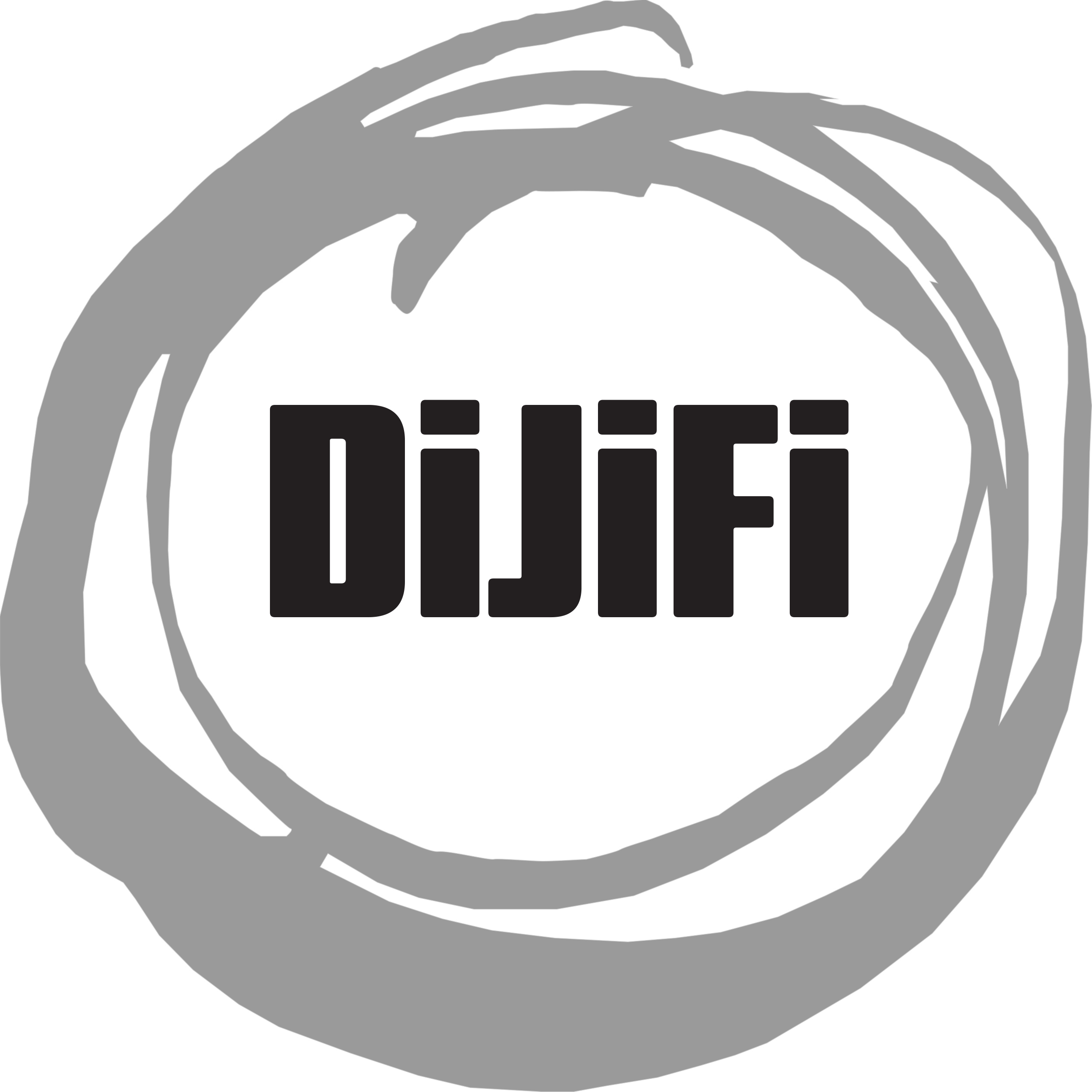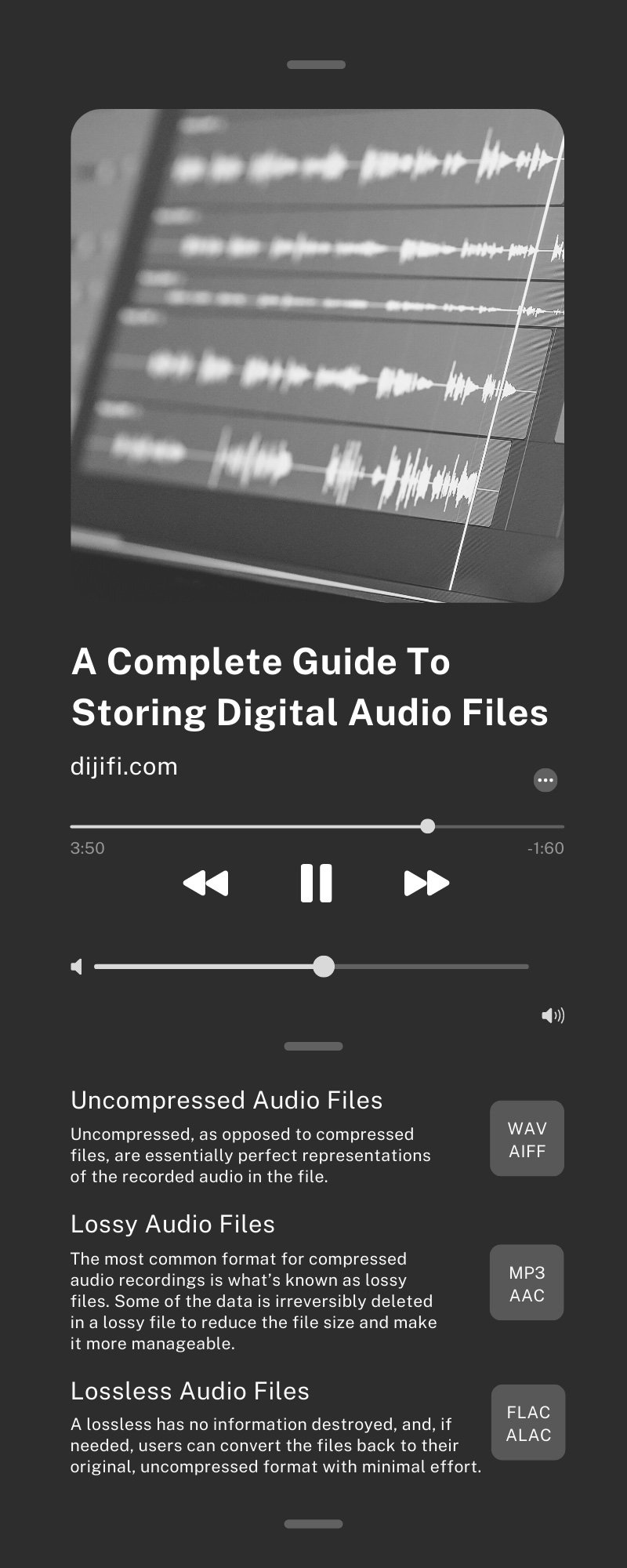A Complete Guide To Storing Digital Audio Files
Sorting and storing digital audio files can be confusing for those not familiar with the terms and procedures. That’s where our guide comes in! We’ll take you through what you need to know about digital audio files, including compressed versus uncompressed and the various file formats of each.
Compressed vs. Uncompressed Audio Formats
When storing and organizing digital audio files, the format is a significant decision that will affect the quality, size, and ability to edit and use the audio recordings. In basic terms, digital audio files come in two formats: compressed and uncompressed.
Two subsections are within the compressed format known as lossy and lossless audio files. We’ll explain the key things you need to know about uncompressed, lossy, and lossless files to better understand your digital library.
Uncompressed Audio Files
Uncompressed, as opposed to compressed files, are essentially perfect representations of the recorded audio in the file. Since you’re not compressing or adjusting the files, the sound quality is pitch-perfect and will remain that way even if you copy it over multiple formats—if the files remain uncompressed.
The most apparent downside to uncompressed audio files is their size. They may be the best in terms of quality, but you won’t be able to store nearly as many uncompressed files as compressed. For instance, a WAV file (uncompressed) can be as much as 10-times larger than an MP3 file (compressed).
Lossy Audio Files
The most common format for compressed audio recordings is what’s known as lossy files. Some of the data is irreversibly deleted in a lossy file to reduce the file size and make it more manageable.
If done correctly, the sound quality shouldn’t degrade too much, and users get a much smaller file size that’s ideal for distribution over the internet. This convenience is why most audio streaming services, such as Spotify, utilize lossy audio files to manage a vast and extensive music and podcast library.
Lossless Audio Files
Not as many users may utilize it as the lossy format, but the lossless audio format has been growing in popularity over recent years. A lossless has no information destroyed, and, if needed, users can convert the files back to their original, uncompressed format with minimal effort.
Lossless files are a bit of a middle-ground between compressed and uncompressed—the sound quality is superior to compressed, but they’re not as huge as uncompressed. They’re still substantially larger audio files than compressed, just not as huge as uncompressed.
Fun Fact: The streaming service TIDAL is known for utilizing lossless audio, and many other services like Amazon Music offer the format at an additional cost.
Uncompressed Audio Formats
Within the uncompressed audio umbrella are two primary formats you should know about: WAV and AIFF. As you’ll see, the difference between the two is mostly what devices and media players they’re compatible with while retaining the same advantages and disadvantages.
WAV
If you have any experience with audio formats, you’ve almost undoubtedly run into WAV files before. They’re the default audio format on Windows as it preserves the audio recording in its entirety without any compressions or manipulations. Importantly, WAV files can also be played on Apple devices.
For those recording music or vocals in a studio, WAV will be the ideal format as it offers a pure and unchanged sound. The downside is that, as we mentioned, the file size is massive, and although it may be great for single recordings and files, it will be a challenge to manage a huge library of them.
AIFF
The Audio Interchange File Format (AIFF) is the Apple equivalent of the WAV file format. While WAV is the standard for Windows operating systems, AIFF is the standard for Apple and Mac devices. Please note, Windows Media Player is capable of playing AIFF Files.
There’s minimal to no difference between the two in their benefits and shortcomings—they offer excellent quality with the drawback of enormous size.
Lossy Audio Formats
Lossy is the audio format you’ve probably listened to the most if you get your music and podcasts from an internet streaming platform such as Spotify or Apple Music. You’ve almost certainly run into these file formats if you’ve ever downloaded or managed an audio library on your laptop or computer.
MP3
You don’t have to be an audiophile to know what an MP3 file format is. By far the most popular form, MP3 is synonymous with digital audio and is typically used for distributing audio from music to podcasts.
MP3s are much more efficient than uncompressed audio files without sacrificing too much in quality. High-bit-rate MP3s are like improved MP3 files that give users even better sound without the huge file sizes of uncompressed audio.
AAC
Advanced Audio Coding (AAC) offers better compression-to-quality ratios than MP3 and is considered better for pure sound without sacrificing efficiency. It’s one of the most efficient file formats available to users and is an improvement in many ways over the MP3.
The AAC used to be hampered by compatibility but is now widely supported by most operating systems and browser media players.
Lossless Audio Formats
Recently, lossless audio formats have ticked up in popularity as more listeners are looking for better sound quality, even if it means risking storage space. The two most common lossless formats are FLAC and ALAC.
FLAC
The Free Lossless Audio Codec (FLAC) is the most popular lossless format today since it’s free and open-sourced. FLAC isn’t very efficient in file size, but the high-quality resolution is considered second-to-none.
Audiophiles consider FLAC the “high-definition” format for digital audio, so you’ll probably want to go the FLAC route if quality is your utmost concern.
ALAC
As with the other formats, Apple has to have its own, which is what ALAC represents. It retains the same high-definition qualities of FLAC but is strictly for Apple devices.
Since ALAC is closed-source, it can be tricky to find support for non-Apple devices, and some consider it less efficient than its FLAC counterpart.
Converting Analog to Digital Audio
There’s a precise and detailed process for those who want to convert analog to digital audio. Firstly, equipment such as an analog-to-digital converter (ADC) is needed to take samples of the soundwave.
The ADC converts the analog signals, like the sound from a microphone, into time-sampled signals converted into an audio file. If you don’t have an ADC, we at DiJiFi offer audio transfer services that do the heavy lifting for you.
The intricacies of audio formats and storing digital files can be hard to grasp for many, but we hope our guide has helped clear things up. If you have any more questions about digital audio, or anything else relating to audio files, don’t be afraid to contact the experts at DiJiFi.


